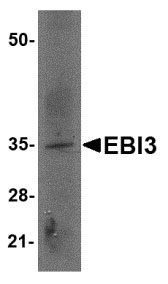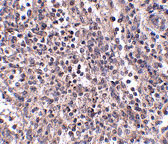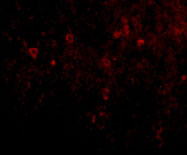EBI3 Antibody
- SPECIFICATION
- CITATIONS
- PROTOCOLS
- BACKGROUND

Application
| WB, IHC-P, IF, E |
|---|---|
| Primary Accession | Q14213 |
| Other Accession | NP_005746, 14577917 |
| Reactivity | Human, Mouse, Rat |
| Host | Rabbit |
| Clonality | Polyclonal |
| Isotype | IgG |
| Calculated MW | 25396 Da |
| Application Notes | EBI3 antibody can be used for the detection of EBI3 by Western blot at 2 µg/mL. Antibody can also be used for immunohistochemistry starting at 2.5 µg/mL. For immunofluorescence start at 20 µg/mL. |
| Gene ID | 10148 |
|---|---|
| Target/Specificity | EBI3; |
| Reconstitution & Storage | EBI3 antibody can be stored at 4℃ for three months and -20℃, stable for up to one year. As with all antibodies care should be taken to avoid repeated freeze thaw cycles. Antibodies should not be exposed to prolonged high temperatures. |
| Precautions | EBI3 Antibody is for research use only and not for use in diagnostic or therapeutic procedures. |
| Name | EBI3 |
|---|---|
| Synonyms | IL27B |
| Function | Associates with IL27 to form the IL-27 interleukin, a heterodimeric cytokine which functions in innate immunity. IL-27 has pro- and anti-inflammatory properties, that can regulate T-helper cell development, suppress T-cell proliferation, stimulate cytotoxic T-cell activity, induce isotype switching in B-cells, and that has diverse effects on innate immune cells. Among its target cells are CD4 T-helper cells which can differentiate in type 1 effector cells (TH1), type 2 effector cells (TH2) and IL17 producing helper T-cells (TH17). It drives rapid clonal expansion of naive but not memory CD4 T-cells. It also strongly synergizes with IL-12 to trigger interferon-gamma/IFN- gamma production of naive CD4 T-cells, binds to the cytokine receptor WSX-1/TCCR. Another important role of IL-27 is its antitumor activity as well as its antiangiogenic activity with activation of production of antiangiogenic chemokines. |
| Cellular Location | Secreted. |

Thousands of laboratories across the world have published research that depended on the performance of antibodies from Abcepta to advance their research. Check out links to articles that cite our products in major peer-reviewed journals, organized by research category.
info@abcepta.com, and receive a free "I Love Antibodies" mug.
Provided below are standard protocols that you may find useful for product applications.
Background
EBI3 Antibody: EBI3 is a subunit in two distinct heterodimeric cytokines: interleukin-27 (IL-27) and IL-35. Like interleukin-23 (IL-23), IL-27 is a recently discovered member of the IL-6/IL-12 family of proinflammatory and immunoregulatory cytokines. It exists as a heterodimer composed of the p40-related protein EBI3 and an IL-12 p35-related protein termed p28. IL-27 is produced after activation by antigen-presenting cells and induces proliferation of naïve but not memory CD4+ T-cells. It acts by binding to its receptor WSX-1 (also known as TCCR) and gp130 which results in the activation of a Jak/STAT signaling cascade, suggesting the IL-27 is involved in the regulation of immune processes. It has been suggested that IL-27 can also be used as a therapeutic agent against cancer as it can also induce tumor-specific anti-tumor activity mediated through CD8+ T-cells, IFN-gamma, and T-bet. IL-35 is composed of EBI3 and the p35 subunit of IL-12 and has been reported to have therapeutic effects against collagen-induced arthritis by expanding the population of regulatory T cells and suppressing Th17 cells. At least two isoform of EBI3 are known to exist.
References
Pfanz S, Timans JC, Cheung J et al. IL-27, a heterodimeric cytokine composed of EBI3 and p28 protein, induces proliferation of naïve CD4(+) T cells. Immunity2002; 16:779-90.
Devergne O, Birkenbach M, and Kieff E. Epstein-Barr virus-induced gene 3 and the p35 subunit of interleukin form a novel heterodimeric hematopoietin. Proc. Natl. Acad. Sci. USA1997; 94:12041-6.
Niedbala W, Wei X, Cai B, et al. IL-35 is a novel cytokine with therapeutic effects against collagen-induced arthritis through the expression of regulatory T cells and suppression of Th17 cells. Eur. J. Immunol.2007; 3021-29.
Pfanz S, Hibbert L, Mattson J, et al. WSX-1 and glycoprotein 130 constitute a signal-transducing receptor for IL-27. J. Immunol.2004; 172:2225-31.
If you have used an Abcepta product and would like to share how it has performed, please click on the "Submit Review" button and provide the requested information. Our staff will examine and post your review and contact you if needed.
If you have any additional inquiries please email technical services at tech@abcepta.com.













 Foundational characteristics of cancer include proliferation, angiogenesis, migration, evasion of apoptosis, and cellular immortality. Find key markers for these cellular processes and antibodies to detect them.
Foundational characteristics of cancer include proliferation, angiogenesis, migration, evasion of apoptosis, and cellular immortality. Find key markers for these cellular processes and antibodies to detect them. The SUMOplot™ Analysis Program predicts and scores sumoylation sites in your protein. SUMOylation is a post-translational modification involved in various cellular processes, such as nuclear-cytosolic transport, transcriptional regulation, apoptosis, protein stability, response to stress, and progression through the cell cycle.
The SUMOplot™ Analysis Program predicts and scores sumoylation sites in your protein. SUMOylation is a post-translational modification involved in various cellular processes, such as nuclear-cytosolic transport, transcriptional regulation, apoptosis, protein stability, response to stress, and progression through the cell cycle. The Autophagy Receptor Motif Plotter predicts and scores autophagy receptor binding sites in your protein. Identifying proteins connected to this pathway is critical to understanding the role of autophagy in physiological as well as pathological processes such as development, differentiation, neurodegenerative diseases, stress, infection, and cancer.
The Autophagy Receptor Motif Plotter predicts and scores autophagy receptor binding sites in your protein. Identifying proteins connected to this pathway is critical to understanding the role of autophagy in physiological as well as pathological processes such as development, differentiation, neurodegenerative diseases, stress, infection, and cancer.




